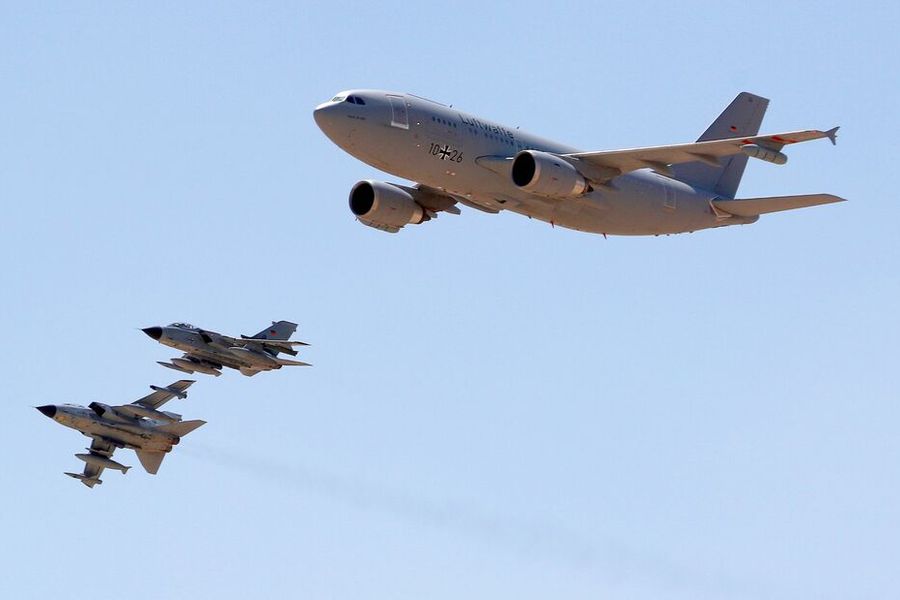COLOGNE – For 30 years the Airbus A310 has been flying around the world for the Air Force with the code 10 + 23. Its end is approaching with rapid steps – it is sweetened with a colorfully painted anniversary tail unit. However, the career of the 10 + 23 did not begin with the military, but with Interflug in the GDR.
In their old days, the 10 + 23 of the flight readiness comes around again properly. Since the corona pandemic hit the world in spring 2020, exotic destinations such as Wuhan in China, Manaus in Brazil or Yerevan in Armenia have also found their way into the A310-304’s logbook.
While in Wuhan at the beginning of February 2020 it was still a question of bringing German citizens home from the alleged Corona source of origin, in July of the same year it went to the Covid hotspot Armenia with aid supplies and doctors on board. At the end of March 2021, 10 + 23 finally brought 80 ventilators to the Amazon, with a stopover on Cape Verde.
Back home in Cologne via Martinique and the Azores. Total flight distance: 18,472 kilometers.
Only attentive observers caught the eye that in the course of these Corona aid flights the approaching departure of the A310 from the services of the Air Force was already casting its shadow: During the first missions, the baptismal name “Kurt Schumacher” was emblazoned in black and gray on the bow of the 10 + 23 , at the end of 2020 the aircraft had to give this name to the new A350-900 10 + 03, which is now available to the federal government for VIP flights all over the world.
The A310 started its voyage to Brazil in March without a name. A month later, at the end of April, she received a colored tail as compensation: Since then, the silhouette of an A310 with contrails, Cologne Cathedral and the Hohenzollern Bridge have adorned the vertical stabilizer of the 10 + 23. The lettering “30 years” is next to it – and reminds us that exactly 30 years ago, on May 1, 1991, the A310’s service life began in flight readiness.
The first widebodies in the GDR
This was preceded by a short but internationally acclaimed interlude as a passenger aircraft. Because the 10 + 23, serial number 503, was originally one of three A310-304s that Airbus delivered to the GDR airline Interflug in 1989. This deal was largely engineered by the then head of the Airbus supervisory board and long-time Bavarian Prime Minister Franz-Josef Strauss.
For Interflug, the A310 was the first widebody, the first western aircraft type ever, and at the same time the one with the greatest range. The carrier proved this directly: On November 21, 1989, an Interflug A310 flew in 13:25 hours from Kumamoto on the Japanese island of Kyushu to Berlin-Schönefeld.
Never before had an Airbus A310 managed such a route non-stop, let alone in such a short time.
Special version A310-304
The later 10 + 23 joined the Interflug fleet on October 30, 1989, eleven days before the fall of the Berlin Wall. There it was initially given the GDR-ABC license plate. Its two sister planes, the DDR-ABA and the DDR-ABB, had been flying for the DDR airline since the end of June 1989.
Interflug used the A310 primarily for flights from Berlin-Schönefeld to Cuba, which were handled non-stop under ideal conditions. However, the crews often made a stopover in Shannon, Ireland, or in Frankfurt, even if the A310-304 used by Interflug had additional tanks and were specially designed for ranges of up to 10,000 kilometers.
GDR becomes D
With the reunification on October 3, 1990, the GDR airbuses initially only changed the license plate: The GDR ABC became the D-AOAC. The A310 stayed with its Schönefeld employer for a few more months, but the end was already sealed. On April 30, 1991, Interflug had to officially cease operations.
The Airbus widebodies went – irony of fate – to the former class enemy: the Federal German readiness to fly. On May 1, they formally began their service there and received the tactical license plates 10 + 21, 10 + 22 and 10 + 23. While the first two A310 mentioned were given a VIP cabin at Lufthansa Technik in Hamburg, the 10 + 23 flew with the Air Force from September 1991 with an economy cabin for 214 passengers.
In retrospect, that was her “luck”: Because the two VIP sisters have long been history at the federal government. They have been replaced by the larger A340-300. An ex-Interflug A310, the former 10 + 21, was converted into a Zero-G aircraft for parabolic flights in 2014. The 10 + 22 went to Iran. Only the 10 + 23 still flies for the Bundeswehr today, along with three (previously four) other A310-300s that came from Lufthansa in the mid-1990s.
Apart from the relief missions mentioned above, the troop transport is part of the daily bread of the 10 + 23. After all, it is the only active A310 in flight readiness that has not been converted to the MRTT (Multi-Role Tanker Transport) standard.
last chapter
Regardless of whether it is an MRTT or PAX version: the A310’s time in the Bundeswehr is inexorably drawing to a close. With the 10 + 27 “August Euler”, the first representative was thrown away in spring 2021, and the rest of the A310s should also be history by 2022 at the latest. Two brand new A321LR will follow in their footsteps.
What then happens to the 10 + 23 and her stepsisters from Lufthansa in detail is not entirely clear. However, each of the four Air Force A310s that are still active is well over 30 years old. Most of their flying careers should therefore all be behind them. The 10 + 23 flies towards the supposed end with a colorful tail.
© FLUG REVUE – Patrick Zwerger | Fig .: Air Force | 05/30/2021 8:37 AM
–


